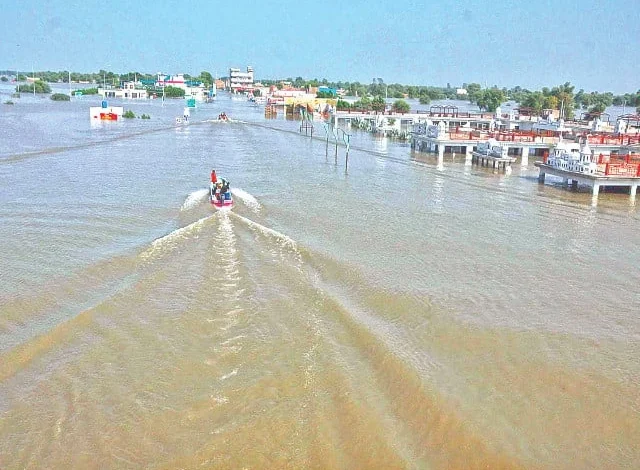Floodwaters wash away the M5 section

Floodwaters have washed away another portion of the Multan-Sukkur Motorway (M-5) close to Jalalpur Pirwala, further disrupting southern Punjab, which is already experiencing what officials say is the worst floods since 1956.
The Sutlej River’s strong flow toward the Chenab triggered a breach in the motorway’s eastern track, which led to its collapse, according to motorway police. Earlier in the week, the western track had already been swept away.
Staff from the National Highway Authority (NHA) and motorway police are still on the scene, using large equipment to move boulders in an attempt to stem the water’s flow.
For over a week, the M-5 between Multan and Jhangra has been closed. A diversion plan has been released by the authorities, which calls for drivers going from Multan to Sukkur to be diverted from Shah Shams Interchange to the National Highway. They may then re-enter the motorway at Uch Sharif. Traffic is being redirected in reverse order for vehicles heading into Multan from Sukkur. Road users’ policemen and patrols are in place to assist drivers, officials emphasized.
Irfan Ali Kathia, the Girector General of the Punjab Provincial Disaster Management Authority (PDMA), stated that the flooding is the worst since 1956.
He told the media that defenses had been overpowered by the simultaneous management of excessive flows in the Sutlej, Chenab, and Ravi rivers. Against a capacity of 900,000 cusecs, water volumes at the Qadirabad headworks on the Chenab exceeded 1.05 million cusecs. Water levels remained dangerously high for days after similar surges in Sidhnai on the Ravi and in some areas of the Sutlej.
According to Kathia, the Chenab’s long-term high water levels hindered downstream inflows from the Ravi and Sutlej, causing backflows that led to breaches at multiple headworks. He also mentioned that one of the main causes of the submersion of entire settlements was development on natural waterways. He claimed that because so many people in southern Punjab disregarded early warnings, officials were under tremendous pressure to perform last-minute rescues.
The floods in Punjab have affected around 4.7 million people, of whom 2.2 million have been relocated to safer places. In 27 districts, about 83,000 brick homes and 300,000 mud homes were damaged.
A relief package for those impacted has been announced by Chief Minister Maryam Nawaz. Families who lost their homes completely would receive Rs. 1 million, while those whose homes were only partially destroyed will receive Rs. 500,000. Farmers will receive Rs. 20,000 per acre for damaged crops, and livestock compensation varies from Rs. 150,000 to Rs. 500,000 per animal.